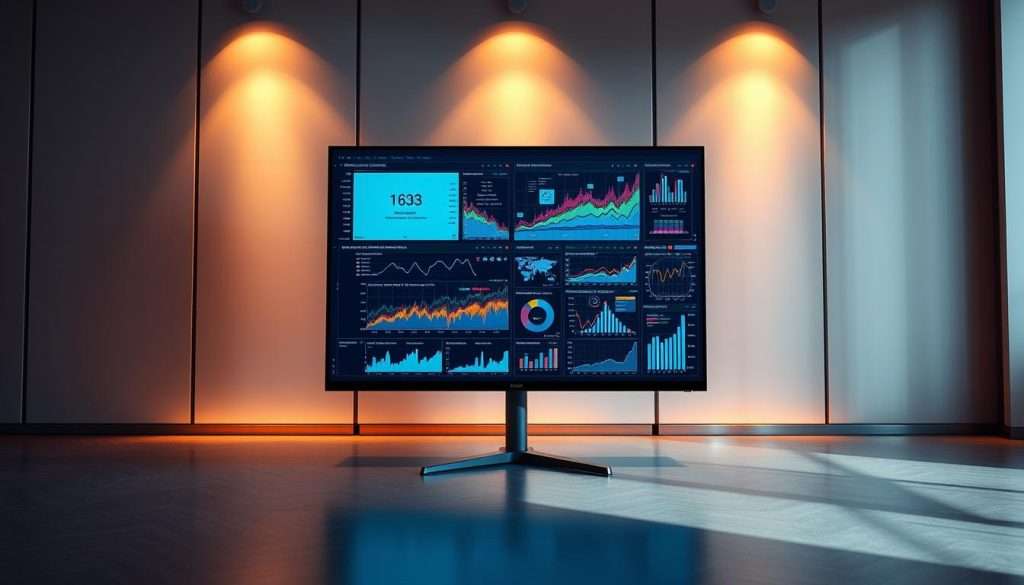Are you tired of feeling overwhelmed by complex information and struggling to stay productive? Can a simple change in the way you process information make a significant difference?
We often rely on text-based learning. But using visual elements can simplify complex information and boost our creativity. Visual thinking is key for students and professionals to work and learn better.
By adding visual thinking to our daily routine, we can solve problems better and work more efficiently. In this article, we’ll look at how visual thinking can make us more productive.
Key Takeaways
- Simplify complex information using visual elements
- Enhance creativity and problem-solving capabilities
- Improve productivity by incorporating visual thinking
- Transform the way you work and learn
- Boost your efficiency with visual thinking techniques
What is Visual Thinking?
Visual thinking uses pictures and diagrams to explain ideas. It makes complex concepts easier to grasp and share. This way, we can simplify information and present it clearly and engagingly.
The Science Behind Visual Processing
Our brains handle pictures faster than words. This is because pictures are processed in a special part of the brain. Using visuals taps into this powerful ability.
How Visual Thinking Enhances Cognitive Function
Visual thinking boosts our brainpower in many ways. It helps us remember better, solve problems, and share ideas more clearly.
The Picture Superiority Effect
The Picture Superiority Effect shows that pictures help us remember better than words. This proves how visual thinking can improve our memory and recall.
Visual-Spatial Intelligence
Visual-spatial intelligence lets us think in pictures and understand visual information. People with strong visual skills find visual thinking very helpful. They can easily grasp and work with complex visuals.
| Visual Thinking Benefits | Description |
|---|---|
| Enhanced Retention | Visual information is retained better than text-based information. |
| Improved Problem-Solving | Visualizing problems can lead to more innovative solutions. |
| Better Communication | Visual aids can make complex ideas more accessible. |
The Benefits of Visual Thinking for Productivity
Visual thinking can greatly improve your productivity and efficiency. It’s not just about making nice pictures. It’s a powerful way to better process and remember information, solve problems, and share ideas with others.
Enhanced Information Retention and Recall
Visual thinking makes it easier to remember important details. It turns complex data into simple visuals. This way, you can recall key points more easily. Research shows that visuals are better remembered than text.
Accelerated Problem-Solving Capabilities
Visual thinking speeds up problem-solving. It lets you see complex issues in simpler parts. Tools like mind maps help spot patterns and connections that text might miss.
Improved Communication Efficiency
Visual aids make communication clearer and faster. They help send messages that are easy to understand. This is very helpful in team work and presentations.
Reduced Mental Fatigue
Visual thinking also cuts down on mental tiredness. It gives a break from too much text. Adding visuals to your work keeps your focus and energy up all day.
Core Visual Thinking Techniques
Let’s explore the key visual thinking techniques that boost productivity and creativity. These methods help organize ideas, create visual notes, and map complex relationships better.
Mind Mapping for Idea Organization
Mind mapping is a strong tool for organizing ideas and structuring thoughts. It creates a visual map with a central idea and branches out to related concepts.
Radial Structure Basics
A radial structure is key to mind mapping, where ideas spread out from a central point. This structure makes it easy to organize and remember information.
Color Coding Systems
Color coding in mind maps adds to organization and looks. Different colors can show different themes, priorities, or categories, making maps clearer.
Sketchnoting Fundamentals
Sketchnoting mixes note-taking with drawing to make engaging notes. It’s great for capturing, retaining, and reviewing information quickly.
Concept Mapping for Complex Relationships
Concept mapping is great for understanding complex relationships between ideas or concepts. It shows how different elements connect.
Visual Metaphors and Analogies
Visual metaphors and analogies make complex ideas simple and relatable. They create a shared language and understanding, useful for teams or presentations.
By using these visual thinking techniques daily, you can boost productivity, creativity, and communication of complex ideas.
How to Master Visual Note-Taking
To get good at visual note-taking, you need to know the basics and practice often. It’s about mixing text and pictures to make notes fun and easy to remember.
Essential Supplies for Effective Visual Notes
You’ll need some basic things to start. These are a notebook, pens, markers, and any drawing tools you like. Try out different tools to see what works best for you.
Developing Your Basic Visual Vocabulary
Building a visual vocabulary is key. Learn simple icons and symbols to share complex ideas fast.
Simple Icons and Symbols
Begin with basic shapes and symbols. Use arrows for movement and simple faces for emotions or reactions.
Text-Image Balance
It’s important to balance text and images. Too much text can clutter your notes, while too many images can confuse them.
Step-by-Step Practice Exercises for Beginners
Practice is essential to get better at visual note-taking. Start with simple tasks like drawing shapes, making icons, and summarizing texts in your words.
| Exercise | Description | Benefit |
|---|---|---|
| Drawing Basic Shapes | Practice drawing circles, squares, and triangles. | Improves fine motor skills and hand-eye coordination. |
| Creating Simple Icons | Design simple icons to represent common concepts. | Enhances your visual vocabulary. |
| Summarizing Information | Summarize a piece of text using your own words and simple visuals. | Improves comprehension and retention. |
Visual Problem Solving Strategies
Visual thinking is a great tool for solving tough problems. It uses visual tools to simplify complex issues. This makes it easier to find solutions.
Breaking Down Complex Problems Visually
To tackle complex problems, start by breaking them down. Use diagrams, flowcharts, or mind maps to organize the problem. This helps us see how different parts are connected and where the problem starts.
Techniques for breaking down problems visually include:
- Identifying main issues and sub-issues
- Creating a visual hierarchy of problem components
- Using different colors or symbols to represent various aspects
Creating Effective Decision Trees and Flow Charts
Decision trees and flow charts are key for planning solutions. They show the steps and outcomes of decisions clearly. This makes the decision-making process easier to follow.
| Tool | Purpose | Benefits |
|---|---|---|
| Decision Trees | Visual representation of decisions and their outcomes | Simplifies complex decisions, highlights potential risks and rewards |
| Flow Charts | Diagrammatic representation of processes and flows | Clarifies steps in a process, identifies bottlenecks or inefficiencies |
Visual Root Cause Analysis Methods
Root cause analysis is key to finding the real reasons behind problems. Visual tools like fishbone diagrams help organize possible causes. This makes it easier to find the root cause.
Using these strategies, we can solve complex problems better. Whether it’s breaking down problems, making decision trees, or doing root cause analysis, visual thinking helps us find creative solutions.
Implementing Visual Thinking in Meetings
Visual thinking can change how we hold meetings. It makes them more fun and effective. By adding visuals, we help everyone work together better and understand ideas clearly.
Graphic Facilitation Basics for Beginners
Graphic facilitation is a great way to capture and organize meeting info in real-time. You’ll need markers, sticky notes, and a big writing area to start. It’s all about listening well and turning complex ideas into simple pictures.
How to Create Visual Agendas That Engage
A visual agenda sets the stage for a productive meeting. First, pick the main topics to talk about. Use icons, images, or simple drawings to show them. This not only catches people’s attention but also helps them see the meeting’s plan and goals.

Techniques for Capturing Ideas Visually in Real-Time
Getting good at capturing ideas visually takes practice. But it’s key for great meetings. You can use mind maps, sketchnoting, or visual lists. The goal is to make the info easy to follow and fun for everyone.
Post-Meeting Visual Documentation
It’s important to document what was discussed and decided after the meeting. Make a visual summary with key points, actions, and decisions. This way, everyone can see what was agreed on, even if they missed the meeting.
| Technique | Description | Benefits |
|---|---|---|
| Graphic Facilitation | Visually capturing and organizing information in real-time | Enhances collaboration, clarifies complex information |
| Visual Agendas | Representing meeting topics visually | Grabs attention, sets clear expectations |
| Real-Time Visual Capture | Using visual techniques to capture ideas during meetings | Makes information accessible, enhances engagement |
| Visual Documentation | Creating visual summaries post-meeting | Clearly communicates outcomes, action items, and decisions |
Digital Tools for Visual Thinking
In today’s digital world, visual thinking is easier than ever. Thanks to many new tools, we can organize, visualize, and share ideas easily. Digital platforms and apps make it simple.
Top Mind Mapping Software Compared
Mind mapping is a key visual thinking method that digital tools have improved a lot. Tools like MindMeister, XMind, and Coggle help create detailed mind maps. They also let you work with others and connect with other tools.
When picking a mind mapping tool, think about how easy it is to use. Also, consider how well it works for teamwork and if it fits with your devices.
Digital Whiteboard Platforms for Teams
Digital whiteboards are key for team work, even when everyone is not in the same place. Mural, Google Jamboard, and Microsoft Whiteboard let teams brainstorm and plan together. They have features like sticky notes and video calls, perfect for visual thinkers.
Visual Collaboration Tools for Remote Work
Visual collaboration tools are vital for remote teams to stay connected. Tools like Trello, Asana, and Slack use visuals like boards and charts. They help teams organize tasks and projects, making work clearer and more productive.
Mobile Apps for Visual Thinkers On-the-Go
For those always on the move, mobile apps are great for capturing ideas. Evernote, SimpleMind, and Adobe Draw offer features for note-taking and drawing. These apps sync across devices, so your ideas are always with you.
Visual Storytelling for Impactful Presentations
Visual storytelling changes the game for presentations. It combines powerful stories with visuals to grab your audience’s attention. This makes your message stick in their minds.
Creating Compelling Visual Narratives
To make a strong visual story, first figure out your main message. Use images, charts, and graphs that fit your story. These visuals help people understand complex ideas.
Remember, the right pictures can make your presentation stand out. They make it more interesting and effective.
Designing Slides That Communicate, Not Complicate
When making your slides, keep it simple and clear. Don’t clutter your slides. Each slide should have a clear goal.
Use data visualization to make complex data easy to see. For example, a good infographic can show a lot of information quickly.

Visual Storytelling Techniques for Different Audiences
Different people need different approaches to visual storytelling. Know your audience well to create a story that speaks to them. Use visual metaphors or adjust the details to connect with your audience.
Overcoming Common Visual Thinking Challenges
Visual thinking can change the game, but it comes with its own set of challenges. Let’s dive into how to beat them. As you start your visual thinking journey, you might face obstacles that slow you down. We’ll tackle some common challenges and share strategies to overcome them.
Conquering the “But I Can’t Draw” Syndrome
Many think you need to be an artist to think visually. But visual thinking is about sharing ideas, not making art. You don’t have to draw well to think visually. Simple symbols and diagrams can powerfully share complex ideas.
To beat this, start with simple drawing. Begin with basic shapes and move to more complex ones. The goal is to get comfy using visuals to share ideas, not to make art.
Managing Visual Information Overload
Handling too much visual info is another big challenge. With so many things vying for your attention, it’s hard to focus. To solve this, simplify your visuals. Use clear labels and group similar info together.
Mind mapping and concept mapping can help organize your thoughts. These tools make your visuals clearer and easier to understand.
Finding and Developing Your Personal Visual Style
Finding your visual style is key to effective visual thinking. Try out different colors, shapes, and icons to see what works for you. Your style should show your unique view and goals.
Don’t hesitate to experiment and refine your visuals. As you get better at visual thinking, your style will grow and become more personal and effective.
Integrating Visual Methods in Text-Heavy Environments
Often, you’ll need to mix visual thinking into text-heavy settings. Look for chances to add visuals to text. Use diagrams and infographics to make text easier to understand.
By adding visuals to your work, you make it more engaging and effective. The trick is to balance text and visuals, using each to support the other.
Visual Learning Tools for Different Learning Styles
Teachers can make learning better by using visual tools. These tools fit different learning styles, helping everyone learn more. They are great for both teachers and students.
Adapting Visual Methods for Various Cognitive Preferences
People learn in their own way. Visual tools can be changed to fit these differences. Some like pictures and diagrams, while others prefer videos or interactive graphics.
Teachers can pick the best visual tools for their students. This makes learning more fun and effective.
Combining Visual with Auditory and Kinesthetic Learning
Visual learning is strong, but it’s even better with sound and touch. For example, using diagrams and charts while talking about a topic. Then, having students do a hands-on activity.
This mix makes learning more fun and helps students remember better.
Creating Personalized Visual Learning Systems
Personalized learning is very important. Students can make their own visual aids like mind maps. This helps them understand better and feel more involved in their learning.
Teaching Others Through Visual Methods
Teachers can use visual tools to teach and empower students. By teaching students to make good visual presentations, they learn valuable skills. These skills help them in many areas of life.
Conclusion: Transforming Your Workflow Through Visual Thinking
We’ve seen how visual thinking can make work better and change how we do things. By using the methods we talked about, you can make big improvements in your work and learning.
Visual thinking helps you organize ideas, solve tough problems, and talk better. Using visual tools every day will make you less tired and more productive.
To start making your workflow better, try simple visual thinking like mind maps or sketchnotes. As you get better, you can try more advanced ways, like solving problems visually or using graphics to help others understand.
By using visual thinking, you’ll see things differently, make your work flow better, and reach your goals faster. So, start today and see how visual thinking can help you.

